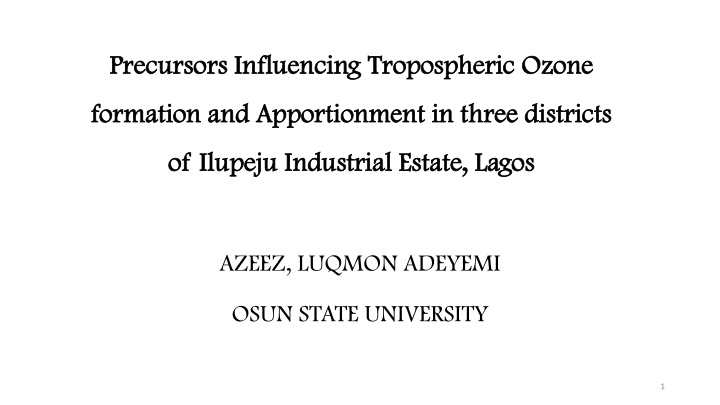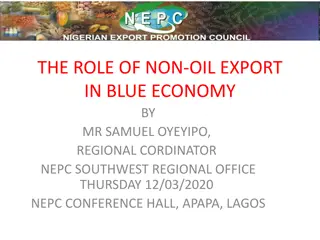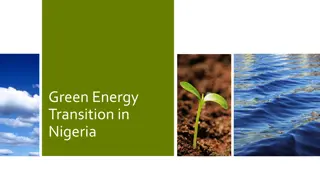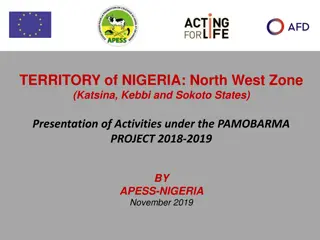
Tropospheric Ozone Formation in Ilupeju Industrial Estate, Lagos
Explore the factors influencing tropospheric ozone formation and apportionment in Ilupeju Industrial Estate, Lagos. Learn about the sampling methods, results, and discussion on air pollution in developing countries and cities. The study delves into the effects of ozone on health and environment, presenting data on pollutant concentrations and meteorological parameters.
Download Presentation

Please find below an Image/Link to download the presentation.
The content on the website is provided AS IS for your information and personal use only. It may not be sold, licensed, or shared on other websites without obtaining consent from the author. If you encounter any issues during the download, it is possible that the publisher has removed the file from their server.
You are allowed to download the files provided on this website for personal or commercial use, subject to the condition that they are used lawfully. All files are the property of their respective owners.
The content on the website is provided AS IS for your information and personal use only. It may not be sold, licensed, or shared on other websites without obtaining consent from the author.
E N D
Presentation Transcript
Precursors Influencing Precursors Influencing Tropospheric Tropospheric Ozone Ozone formation and Apportionment in three districts formation and Apportionment in three districts of of Ilupeju Ilupeju Industrial Estate, Lagos Industrial Estate, Lagos AZEEZ, LUQMON ADEYEMI OSUN STATE UNIVERSITY 1
OUTLINE INTRODUCTION SAMPLING METHODS RESULTS AND DISCUSSION CONCLUSION 2
Air pollution in developing countries and cities Tropospheric ozone formation: photo-oxidation of the precursor gases such as CO, CH4 and non-methane hydrocarbons in the presence of sufficient amount of nitrogen oxide (NOx) (Volkamer et al., 2010; Kgabi and Sehloho, 2012) NO2 + UV photons (hv) O + NO O + O2 O3 Effects of tropospheric ozone highly corrosive, irritant to lung, respiratory inflammation, impairment of photosynthesis (Nair et al., 2002, Olajire and Azeez, 2014) 3
Sampling Sampling location location Ilupeju Industrial Estate is one of the industrial estates established in Lagos in Oshodi-Isolo, Local Government Area. Industries situated in the districts are shown on the map Rida Plastics Apapa Oworonshokin Express Atlantic Manufacturing Company Sl3 Town Planning Way PZ Cussons Sl1 Industrial Crescent Industrial Crescent Industrial Crescent Ilupeju Industrial Avenue Nestle Industries Absco Industries Pharmchem Industries Agege Motor Road Kiwi Industries Glaxosmithkline Adepegba Street Sl2 Motor Garage Esther Osiyemi Street Figure 1: Map of Ilupeju Industrial estate showing sampling locations Measurement and analyses of hazardous pollutants, meteorological parameters, ozone and volatile organic compounds were done according to the methods of Olajire et al., (2011); Olajire and Azeez (2014) 4
RESULTS AND DISCUSSION Table 1: Average concentrations of toxic pollutants and meteorological parameters Pollutants Pollutants SL SL1 1 SL SL2 2 SL SL2 2 Mean Mean Mean NO NO2 2 (ppm) (ppm) 1.1 0.23 0.56 0.03 0.98 0.29 NO NO (ppm) (ppm) 0.2 0.01 0.08 0.02 0.23 0.05 SO SO2 2 (ppm) (ppm) 0.52 0.13 0.32 0.19 0.81 0.21 CO CO (ppm) (ppm) 14.6 1.73 13.90 3.30 15.59 1.07 O O3 3 (ppb) (ppb) 17.2 1.40 17.0 1.10 18.8 2.50 TVOC TVOC (ppm) (ppm) 8.22 0.13 6.86 0.05 7.08 0.12 (ms- -1 1) ) Wind Wind speed speed (ms 0.74 0.04 1.00 0.16 1.26 0.22 Temperature Temperature ( (o oC) C) 32.84 0.99 32.22 0.49 32.68 1.04 Pressure Pressure (hPa) (hPa) 14.15 0.07 14.52 0.14 14.59 0.61 Heat Heat Index Index ( (o oC) C) 35.40 3.95 36.70 1.74 36.22 2.49 Humidity Humidity ( (% %) ) 66.26 1.48 66.14 1.87 64.88 2.13 TVOC/NO TVOC/NOx x 6.32 10.72 5.85 NOx Nitrogen oxide, SO2 Sulphur dioxide, CO Carbon monoxide, TVOC Total volatile organic compounds 5
1.5 Two peaks shown could be as a result of vehicular activities Nox (ppm) 1 coinciding with rush hours (Wang et al., 2002; Duan et al., 0.5 2008 0 7 8 9 10 11 12 13 14 15 16 17 18 Time (hour) Figure 2a: Diurnal variations of nitrogen (IV) oxide (NO2) Diurnal pattern shows two peaks; 11.00 13.00 and 15.00. 25 High peaks of O3 observed in the noon could be due to the 20 Ozone (ppb) 15 formation of ozone from photo-oxidation of the precursor 10 5 gases such as CO, CH4 and non-methane hydrocarbons in 0 7 9 11 13 15 17 the presence of sufficient amount of nitrogen oxide (NOx) Time (hour) Figure 2b: Diurnal variations of ozone (O3) (Nair et al., 2002 10 TVOC concentration 8 Peaks of TVOC coincided with rush hours 6 (ppm) 4 2 0 7 9 11 13 15 17 Time (hour) 6 Figure 2c: Diurnal variations of total volatile organic compounds (TVOC)
Table 3: Factor analysis of toxic pollutants and meteorological parameters Communalities Pollutants Component Extraction F1 F2 F3 .850 Nitrogen oxide 0.882 .945 Sulphur (IV) oxide 0.512 .839 Carbon (II) oxide 0.618 0.617 .795 Pressure 0.850 .842 Wind speed 0.899 .903 Temperature 0.610 0.568 .930 Ozone 0.919 .653 TVOCs 0.710 0.799 Extraction Method: Principal Component Analysis. Rotation Method: Varimax with Kaiser Normalization. Only factor loadings 0.5 listed 7
Table 4: Average concentrations and ozone formation abilities of VOC species Concentration ( gm Concentration ( gm- -3 3) ) MDL ( gm MDL ( gm- -3 3) ) MIR MIRa a O O3 3 formation ( gm formation ( gm- -3 3) ) VOC VOC SL1 SL2 SL3 SL1 SL2 SL3 Alkane H/C Alkane H/C Ethane Ethane Propane Propane Butane Butane Pentane Pentane Hexane Hexane Heptanes Heptanes Octane Octane Decane Decane Alkene H/C Alkene H/C Ethene Ethene Propene Propene Aromatic H/C Aromatic H/C Benzene Benzene Toluene Toluene Ethylbenzene Ethylbenzene m,p m,p- -Xylene Xylene o o- -xylene xylene Chlorinated H/C Chlorinated H/C TCE TCE TeCE TeCE B/T B/T Toluene/ m,p Toluene/ m,p- -xylene 10.39 0.50 9.22 0.76 12.09 0.27 8.46 0.49 2.19 0.31 5.58 0.52 4.81 0.15 2.65 0.45 7.89 0.13 7.61 0.28 13.27 1.12 10.55 1.45 7.12 0.61 2.64 0.05 9.33 0.99 6.03 0.13 11.70 2.14 7.47 0.69 10.03 0.23 5.66 0.27 4.41 0.04 5.51 0.08 2.53 0.19 3.88 0.22 0.64 0.1 0.1 0.1 0.1 0.2 0.3 0.3 0.25 1.15 2.54 3.94 5.61 7.15 8.68 11.60 2.60 10.60 30.71 33.33 12.29 39.90 41.75 30.74 1.97 8.75 33.71 41.57 39.94 18.88 80.98 69.95 2.93 8.59 25.48 22.30 24.74 41.38 21.96 45.01 6.88 1.01 13.97 2.70 5.27 0.47 17.15 0.40 8.05 0.16 12.75 1.72 0.13 0.6 8.52 26.30 58.62 367.41 44.90 451.05 68.59 335.33 8.45 0.27 13.39 0.03 6.32 0.10 28.53 5.29 10.97 2.52 8.82 0.84 15.58 0.19 4.88 0.12 20.76 0.17 11.51 3.15 9.18 0.50 15.06 3.20 6.78 0.66 22.36 0.81 8.01 0.28 0.19 0.47 0.82 0.51 0.29 1.23 5.96 7.10 19.00 13.70 10.39 79.80 44.87 542.07 150.29 10.85 92.86 34.65 394.44 157.69 11.29 89.76 48.14 424.84 109.74 9.94 0.32 21.39 0.75 0.63 0.45 13.06 0.30 16.61 1.14 0.57 0.75 7.35 0.55 18.26 0.72 0.61 0.67 0.14 0.66 0.64 6.36 83.58 4.70 xylene Xylene/CO Xylene/CO TCE/CO TCE/CO TeCE/CO TeCE/CO 2.71 0.68 1.47 2.32 0.94 1.19 1.95 0.47 1.17 Alkane H/C Alkane hydrocarbons, Alkene H/C Alkene hydrocarbons, Aromatic H/C Aromatic hydrocarbons, Chlorinated H/C Chlorinated hydrocarbons, O3 formation ( gm-3) = a[VOC] MIR, MDL Method detection limit
Benzene to toluene ratio has been used to identify VOCs sources. A B/T ratio of 0.5 has been reported to be characteristic of combustion from vehicular activities while higher values have been reported for bio-fuel burning, charcoal and coal burning (Barletta et al., 2002; Zhao et al., 2004) B/T ratios (table 4) of 0.63, 0.57 and 0.61 for SL1, SL2 and SL3 respectively suggest that vehicular activities were the major VOC contributors to aromatic hydrocarbons emission in this study. The ratios in this study are in agreement with results obtained by (Barletta et al., 2005). Other ratios that can be used as markers to identify VOC emission sources are toluene/m,p- xylene, xylene/CO, TCE/CO and TeCE/CO (Wang et al., 2002; Zhang et al., 2012; Olajire and Azeez, 2014). These ratios are therefore indicators of solvent use relative to combustion sources. Low ratios (table 4) calculated for all locations suggest solvent evaporation. This agrees with results obtained by Zhao et al., 2002; Zhang et al., 2012) 9
Table 5: Factor analysis of VOC species Compounds Communalities Component F2 F1 F3 Extraction 0.922 0.956 0.945 0.942 0.949 0.997 0.991 0.953 0.915 0.892 0.819 0.709 0.890 0.900 0.821 0.987 0.961 ethane propane butane pentane hexane heptane octane decane ethene propene benzene toluene ethylbenzene m/p-xylene o-xylene TCE TeCE 0.948 0.969 0.969 0.674 0.950 0.574 0.835 0.900 0.775 0.947 0.765 0.977 0.962 10 Extraction Method: Principal Component Analysis. Rotation Method: Varimax with Kaiser Normalization. Only factor loadings 0.5 listed
Ozone Ozone Formation Formation and and Apportionment Apportionment The ratio of VOCs/NOx can be used to evaluate whether the production of O3 is VOC- sensitive or NOx-sensitive (Carter, 1994). Morning VOCs/NOx ratios lower than 10 were equated with VOC-sensitive peak ozone and Morning VOCs/NOx ratios greater than 20 correspond to NOx-sensitive peak ozone (Sillman, 1999; Pudasainee et al., 2006). In this study, TVOC to NOx ratios (table 1) are lower than 10 in SL1 and SL3 while it is higher than 10 at SL2. This indicates that at all locations, O3 formation is VOCs sensitive. Photochemical reactivity of measured VOCs were estimated using maximum incremental reactivity (MIR). The results are presented in table 4. m/p xylene was the highest contributor to O3 formation at SL1 and SL3 while propene had highest contribution at SL2. Ethane contributed the least to O3 formation 11
Conclusion Conclusion In this study, we have reported the concentrations of toxic pollutants, volatile organic compounds and meteorological parameters measured in three locations of Ilupeju indusrial Estate. Concentrations of toxic pollutants such as CO, NO2 and SO2 were higher than acceptable limits and were dependent on meteorological parameters such as temperature, pressure, humidity and wind speed. Majority of VOCs ratios revealed solvent related and unburned fuel emissions from these locations except B/T ratio which indicated a traffic related emission. m,p - xylene and propene were the major contributors to O3 formation at SL1, SL2 and SL3 respectively. Ozone determined was VOC sensitive at all locations. PCA of the results showed traffic related emission sources for toxic pollutants and solvent use as sources for VOCs. 12
References References Olajire AA, Azeez L (2014). Source apportionment and ozone formation potential of volatile organic compounds in Lagos, Nigeria. Chemistry and Ecology. 30(2):156-168 Pudasainee D, Sapkota B, Shrestha ML, Kaga A, Kondo A, Inoue Y (2006). Ground level ozone concentrations and its association with NOx and meteorological parameters in Kathmandu valley, Nepal. Atmospheric Environment. 40: 8081 8087. Volkamer R, Sheehy P, Molina LT, Molina MJ (2010). Oxidative capacity of the Mexico City atmosphere Part 1: A radical source perspective. Atmospheric Chemistry and Physics. 10:6969-6991. Kgabi NA, Sehloho RM (2012). Tropospheric Ozone Concentrations and Meteorological Parameters, Global Journal of Scientific Frontier in Research and Chemistry. 12: (2012) 10 21. Nair PR, Chand D, La S, Modh KS, Naja M, Parameswaran M, Ravindran S, Venkataramani S (2002). Temporal variations in surface ozone at Thumba (8.6N, 77 E) a tropical coastal site in India. Atmospheric Environment. 36: 603 610. Barletta B, Meinardi S, Simpson IJ, Khwaja HA, Blake DR, Rowland FS (2002). Mixing ratios of volatile organic compounds (VOCs) in the atmosphere of Karachi, Pakistan.Atmospheric Environment. 36: 3429 3443. 13






















